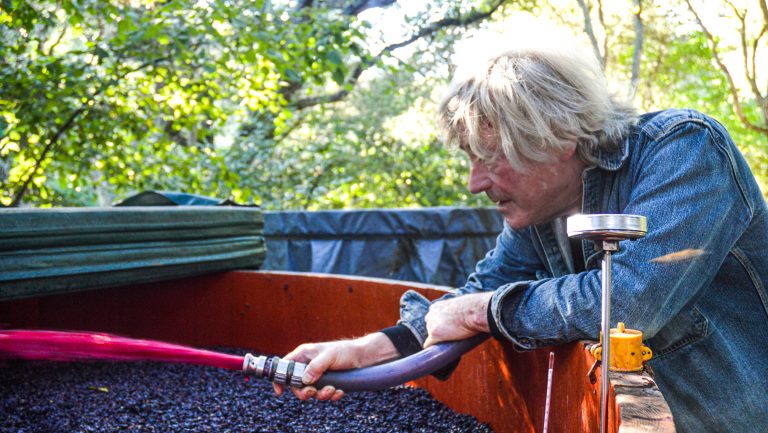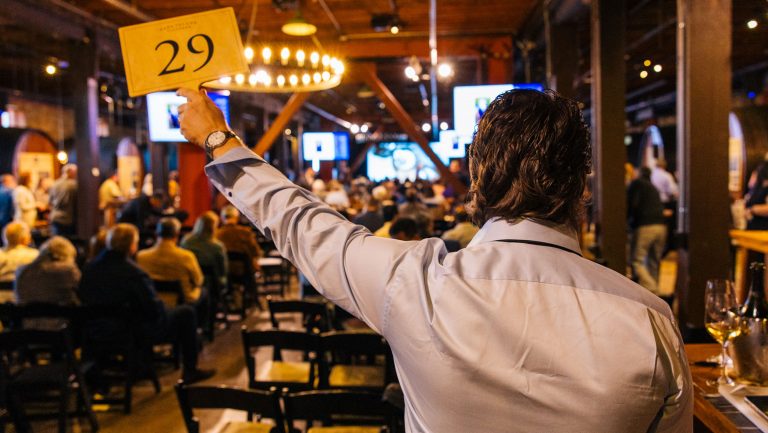Jeff Vejr makes his Willamette Valley, Oregon, wines with an eye to history. For his Golden Cluster label, the old-vines obsessive works primarily with fruit from David Hill Vineyard, originally established in 1883 and subsequently planted, in 1966, to a surprisingly diverse array of wine grape varieties by Oregon wine pioneer Charles Coury. Since he began working with the vineyard, in 2013, Vejr has DNA-identified old plantings of Flora, Savagnin Rose, Perle de Csaba, Chasselas, and Melon de Bourgogne, among others.
Working with such old plantings of such rare varieties, Vejr—who makes biannual pilgrimages to the Republic of Georgia to study that region’s time-honored vinification techniques—favors an ultratraditional winemaking style. “Trying to preserve the historical relevance of the David Hill site has always been the most important aspect of this project,” he says. “There isn’t another vineyard around here. This is its own microclimate.”
For Vejr, an essential part of this process is “ambient fermentation,” which is done in Georgia’s open-air wineries—that is, the wine is made outside. He ferments all of his white and orange wines, as well as his Syrah, alfresco, in 1.5-ton food-grade plastic bins or Burgundy barrels, in an area surrounded by vines. And he’s one of many modern-day winemakers who are questioning the necessity of walls and windows.

Don’t miss the latest drinks industry news and insights. Sign up for our award-winning newsletters and get insider intel, resources, and trends delivered to your inbox every week.
Plenty of small wineries keep fermenting tanks outside from necessity. It’s easier to work a forklift in an unconfined space, after all. But whether their tanks are set up under a roof overhang or out in a parking lot, most winery owners don’t advertise an outdoor crush, since it tends to be driven by budgetary constraints. That’s changing, however, as more winemakers like Vejr begin to question whether an outdoor crush might actually be an advantage, and whether the concept of the vintage should be extended to include the fermentation period rather than just the picking day.
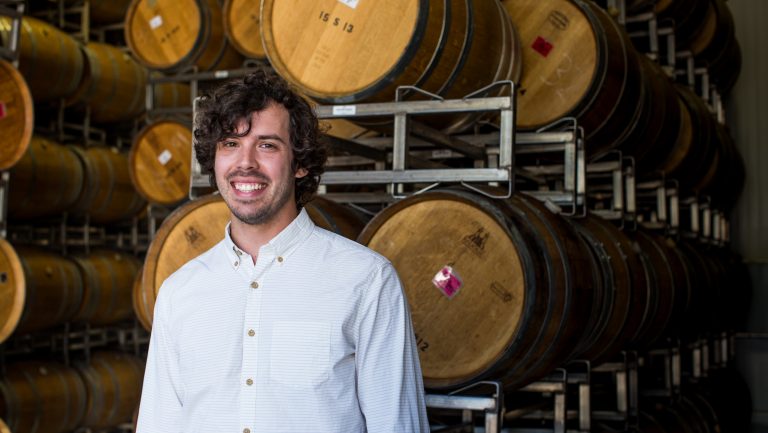
At Scheid Family Wines in California’s Central Coast, for example, Casey DiCesare, an enologist and Scheid’s assistant winemaker, ferments his Chardonnay for the boutique, terroir-driven Metz Road label in a shipping container in the middle of the winery’s Riverview Vineyard. For DiCesare, the point of fermenting among the vines is to access a wild yeast population. “In a winery, commercial yeasts are going to dominate the potentially unique strains that might be out in your vineyard,” DiCesare explains. “We figured the way to isolate native yeasts was to ferment out in the vineyard.”
The Efficiencies of Exposure
Yeast populations aren’t the only impetus winemakers cite for fermenting in the field. Surprisingly, temperature control—or rather, lack thereof—is another.
The idea of fermenting outdoors without temperature controls flies in the face of thousands of years of winemaking history. As long as humans have been making wine, they’ve been digging underground caves, burying amphorae, or even bringing chunks of ice into the cellar in attempts to cool down their fermentations and élévage. With the invention of Portland cement in 1824 came the ability to ferment and store wine in naturally insulating concrete tanks, which keep wine cool even in wall-less winery settings. Soon after that came mechanical refrigeration, with the Bavarian Spaten brewery introducing the first mechanically chilled fermentation vessel in 1873.
Today, contemporary large-scale wineries are visible from the sky due to their massive “tank farms,” or rows of tanks as big as buildings, chilled by glycol with the help of electricity. These humming winemaking vessels might be outdoors, but they’re sealed tight and temperature controlled—like airplane cabins for transforming grapes. In warmer winemaking regions, such as Australia, refrigeration can account for 70 percent of a winery’s electricity bill.
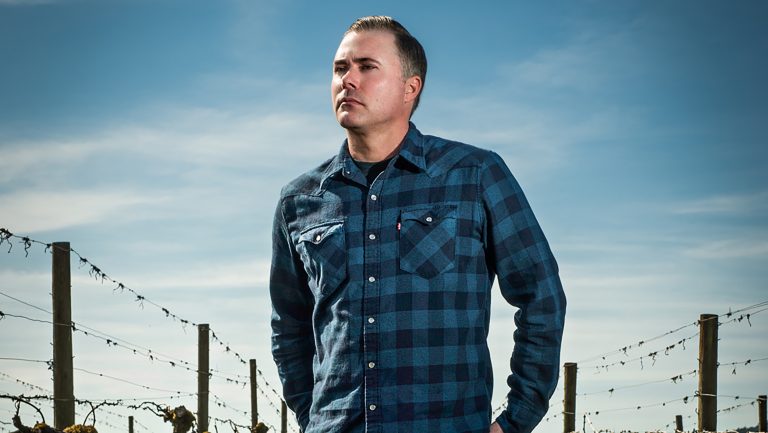
Of course, in many wine-growing regions, it stays too hot at night for unrefrigerated outdoor fermentations to be feasible. But at Golden Cluster in the Willamette Valley, Jeff Vejr believes it’s time for an axiom shift. His primitive setup is the opposite extreme of a tank farm, and yet he claims to achieve the ideal fermentation temperatures working this way.
He says his analog outdoor fermentations tend to be “happier”—cooler overall, without the extreme heat spikes he observes in indoor tanks. “[The fermentation] doesn’t go through cold shock or warm shock,” he says. “It’s like cooking something in a Dutch oven, low and slow. It preserves aromatic and flavor compounds.” And unlike a technologically up-to-date winery, he adds, where the flip of a switch on a glycol jacket can bring about near-instantaneous heating or cooling, “I’m getting a really nice arc of cold at night and warm during the day.”
Alfresco fermentations aren’t something you can Google. There’s no widely used term, like “organic” or “indigenous yeast,” that can identify a winery that’s working outside. You’re more likely to find a large winery’s website advertising its “state of the art”—read “expensive”—facilities than a small producer’s site explicating its penny-pinching practices.
Yet Vejr says he’s proud of the efficiency and cost savings that accompany working en plein air, and his philosophy is that a limited winemaking budget should be celebrated. “I tend to want to ferment as much as possible with less energy consumption, less cost,” he says. “Yeast in the vineyard is free. Sunlight is free. The cool of night is free. I’m trying to maximize quality and limit expense, especially during harvest.”
In the Kelsey Bench AVA in Lake County, California, the Prima Materia vineyard is planted to a large number of grape varieties and clones, with an emphasis on central and southern Italian varieties. The proprietor and winemaker, Pietro Buttitta, punches down each small batch manually, surrounded by vines and olive trees.
Like Vejr, Buttitta says he appreciates the “ebb and flow” of the “introspective” winemaking rhythm that comes with the natural, gradual diurnal heating and cooling rhythm. “We can be at 40 degrees at night and 89 the next day,” he says, adding that his “temperature control” consists of using a forklift to shift bins in and out of the shade of olive and pine trees, or, if necessary, immersing a sealed jug of frozen or hot water in a bin.
While his minimalist setup took some getting used to, Buttitta says that he’s now appreciative of the surprising advantages of working alfresco, even if it means that a few pine needles end up in the grape must. For example, he says, “we have very few sanitation issues, and I think that largely has to do with not being in a building with all sorts of floor drains. We don’t have brett. We don’t have lactobacillus. We don’t need an ozone generator … Microbes don’t like UV light.”
Revisiting Archaic Practices
There are some long-held traditions of outdoor winemaking that rely on solar warmth for their distinctive styles. The Spanish term rancio, for example, describes a wide array of wines that are intentionally aged outdoors, sometimes in barrels and sometimes in large glass demijohns, also known as carboys and bonbonnes.
Having essentially been cooked by the sun, these wines certainly don’t suffer from microbial problems, although, ironically, the term rancio translates as “rancid.” Some critics use the descriptor “rancid butter,” along with “walnuts,” in characterizing their aromatics. According to the Slow Food Foundation for Biodiversity, these unusual wines aren’t particularly well-suited for matching with food.
The rancio style is most closely identified with Southern France’s Roussillon—in the Banyuls, Maury, and Rivesalte AOPs—as well as parts of Spain, particularly Catalonia. In California, winemaker Randall Grahm made a rancio-style wine in 2013, releasing a Bonny Doon Vineyard Vin Gris Tuilé that had aged outdoors in glass demijohns at his Santa Cruz Mountains winery for nine months. Tuilé, meaning “tile,” is the French term for the translucent terra-cotta color that many of these wines take on.
Grahm tells me his sales staff dissuaded him from repeating the experiment, concerned that the Vin Gris Tuilé was too unconventional. “My DTC person at the time was mortally afraid of sending out the VG Tuilé to our club members,” he recalls. That said, he adds, as consumers have become more adventurous in recent years, “the wine has recently been discovered, and at last we’re starting to see some actual sales.”
The best-known American proponent of a more moderate plein-air winemaking regime is Sean Thackrey, whose Thackrey & Co. label, based in Bolinas, California, has had a cultish following since its founding in 1980. “Outdoors is the winery,” Thackrey says of his ascetic facility, which consists of large vats set out in the open air. “I don’t have a separate winery building in the usual sense.”
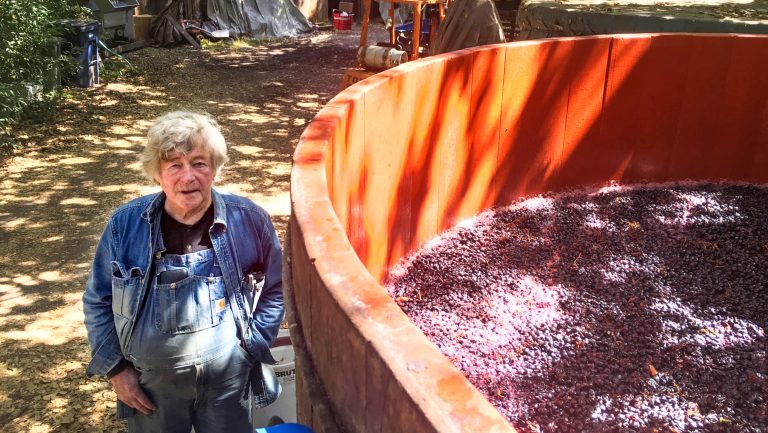
Thackrey ferments wines like his Orion—a field-blend red from Rossi Vineyard, planted in 1905 in St. Helena, that retails for $130 a bottle—on the skins, outdoors, for as long as two months, keeping the wooden fermenter insulated as necessary and covered to keep debris out. “Of course,” he says, “it’s critical to keep the temperature cool, but in Bolinas, that’s hardly difficult, which is what makes outdoor winemaking possible here in the first place.”
And although Thackrey admits that his primitive setup is partly dictated by budget constraints, he also confers with archaic texts for guidance in his winemaking. Thackrey’s widely chronicled practice of leaving fresh-picked grapes out in the bed of his truck for between 24 and 72 hours to “rest” before crushing or pressing, for example, is something he first saw mentioned by the ancient Greek poet and scholar Hesiod and referenced in winemaking texts up through the mid-19th century in Bordeaux.
The result of the rest period, Thackrey says, is “what can only be called a general mellowing of flavors and a softening of flavor structure. The resulting wine is simply more harmonious and subtle than it would have been otherwise. And after all, there’s nothing unusual about fruit continuing to change and ripen when separated from the plant.”
Winemakers who are intentionally vinifying outdoors describe the finished product as—if not exactly rancio—more layered and savory, with salinity, nutty aromatics, and earthiness. “The smells of the vineyard during harvest are really clearly identifiable in the wine,” Vejr of Golden Cluster says of his outdoor fermentations. “There is definitely more of a mossy or pine smell to it.”
But Vejr adds that he’d ferment outdoors even if he didn’t think it would make a difference in the wine. “The air is better outside, especially during harvest. And the view is much better,” he says. “To me, it feels better to ferment in the tranquillity of the out-of-doors than in the chaos of the winery. It’s just really nice to do my punchdowns out here.”

Dispatch
Sign up for our award-winning newsletter
Don’t miss the latest drinks industry news and insights—delivered to your inbox every week.
Katherine Cole is the author of four books on wine, including Rosé All Day. She is also the executive producer and host of The Four Top, a James Beard Award–winning food-and-beverage podcast on NPR One. She is currently working on a fifth book, Sparkling Wine Anytime (Abrams), to be published in Fall 2020.

